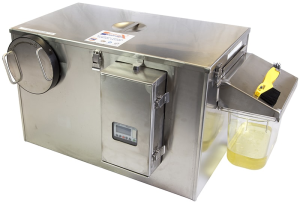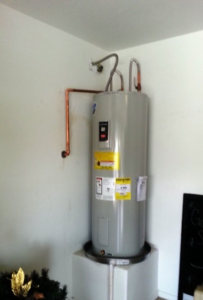Grease Trap Perth is vital to any restaurant’s FOG management system. Neglecting them can result in costly fines, but a properly maintained grease trap can help protect your kitchen against potential issues.
Chemical drain maintenance can reduce FOG buildup in your grease trap, but it needs to be done consistently to see results.

Many communities require the use of grease traps for restaurants, cafes, ice cream shops, and other businesses that produce a lot of FOG waste. These grease traps (also called interceptors) decrease the amount of fats, oils, and grease that is pushed into municipal sewer systems, preventing costly plumbing problems for your business.
Kitchen wastewater that is laden with FOG travels through pipes and into treatment plants, which are not designed to handle large amounts of FOG. As a result, the FOG can coagulate and block pipes, leading to sanitary sewer overflows and costly plumbing repairs for your commercial kitchen. Grease interceptors and traps prevent this by collecting and storing the FOG before it enters the system, thus protecting your business from expensive plumbing repair bills and possible fines from local sanitary sewer authorities.
Typically, these traps are installed underground in a visible outdoor area near the drain line that connects to your kitchen sinks. As wastewater passes through the trap, it separates into liquids and solids. The solids sink and the liquids float, creating two chambers in the trap. The upper chamber is filled with solids, and the lower one is pumped out regularly by a professional grease pump truck. This emptied grease, also known as “brown grease,” is then sent to landfill sites where it is converted into energy. The inlet and outlet pipe of the grease trap must be cleaned regularly to keep it clean, too – otherwise, the inlet and outlet will become clogged with fatty solids that cannot be washed away.
What is a grease trap?
A grease trap (also called a grease interceptor or a grease recovery device) is a plumbing fixture that is designed to keep fats, oils and grease (FOG) from entering the sewer system. FOG can build up in drain pipes, causing clogs and sewer backups. A grease trap helps to protect restaurant kitchens from these problems and ensures that food waste is properly disposed of.
Most city governments require restaurants to have a grease trap or interceptor. These fixtures are designed to catch and contain the FOG from wastewater that is discharged from kitchen sinks and appliances. This prevents the FOG from flowing into the municipal sewer system, where it can cause blockages and overflows that affect the local water treatment plant and community.
The best way to protect your business and comply with government regulations is to regularly clean and maintain your grease trap. FOG waste can cause blockages, backups and overflows that can lead to costly repairs and lost revenue for your restaurant. Regular cleaning and inspection can help to prevent these problems, allowing your grease trap to continue functioning effectively.
How do grease traps work?
In simple terms, a grease trap (or grease interceptor) works by slowing down the water flow of kitchen wastewater so that fats, oils and greases can separate from the rest of the waste. FOGs are lighter in density than water and therefore float to the top of the trap where they can be easily separated from the wastewater and collected for disposal.
Once the wastewater enters the trap it is buffered by a baffle structure to slow down the water flow and improve the efficiency of the separation process. A series of crossover openings allow the wastewater to slowly pass through from one section of the baffle to another. This allows the FOGs to float in the clear water zone while the solids sink and are trapped within the trap.
Grease traps and interceptors are designed to be emptied or pumped out on a regular basis – usually every 2-4 weeks. This is due to the large volume of FOG materials that are being washed down the drains and into municipal sewer systems on a daily basis.
If a trap is not pumped out on a regular basis, the FOGs will eventually reach the sewer system and cause blockages and sanitary sewer overflows. This is why restaurants, hospitals and commercial kitchens are required to have a passive grease trap/grease interceptor installed in order to demonstrate their commitment to responsible FOG management and avoid costly fines and lost business.
What are the benefits of a grease trap?
A grease trap prevents clogs, backups and overflows by intercepting FOG from reaching household plumbing. This protects your restaurant and the local sanitary sewer system from costly damage. Grease traps also mitigate foul odors, and prevent pests like roaches from invading your kitchen area.
Regardless of the type of FOG control device you use, regular cleaning and chemical treatment are critical to its operation. Without these steps, fats, oils and grease (or FOG as it is known in the industry) will build up in your drain system and eventually clog and block all or part of your restaurant’s wastewater drainage lines. This creates a major mess, costs money and time to clean up, and could lead to fines from your town, county or city.
In addition, FOG in the wastewater system will corrode pipes and other equipment. If left untreated, your FOG will form hydrogen sulfide gas (H2S) that is toxic to humans and smells like rotten eggs. This is the cause of thousands of sanitary sewer overflows in the country each year. FOG removal from the sewage system is one of the most expensive parts of your kitchen’s maintenance budget.
Using chemicals for preventative maintenance reduces the frequency of your grease trap pump-outs. It is best to use a product that dispenses the chemicals into your trap on a consistent basis, rather than pouring a large amount at once. This allows the healthy bacteria to establish a colony that digests the FOGs in your trap.
What are the disadvantages of a grease trap?
Over time, accumulated FOG can cause blockages in sewer lines and drains. These blockages, combined with solid wastes like sanitary products, condoms, baby wipes and discarded food scraps, can cause extensive plumbing damage and costly repairs. FOG is the main contributor to these blockages, and a well-functioning grease trap is vital for all food service businesses.
If left untreated, a grease trap can overflow, creating a stinky, messy, and hazardous mess in the kitchen. An untreated grease trap can also attract flies and cockroaches. The best way to prevent an overflow is to invest in a professional grease management solution that includes regular cleanings and maintenance.
Grease traps can become clogged from debris that is not washed away during the cleaning process. These clogs can be in the incoming line or at the crossover point between the 2 compartments. If the clog is in the incoming line, it may interfere with the trap’s ability to properly perform its segregation function and can lead to backups of wastewater from other fixtures in the restaurant.
Clogged grease traps can result in health code violations and lost business. Keeping a grease trap clean is essential for restaurant operators to protect their investment, maintain their food safety certifications, and keep customers happy. By partnering with Eco of Idaho for a one-stop solution, restaurants can ensure their grease traps remain fully operational and avoid costly repair bills.
What are the legal requirements for FOG management?
FOG pollution is a major contributor to sewer line clogs, which can cost businesses thousands in fines and lead to costly repairs. By installing a grease trap and following the best practices for restaurant grease management, you can protect your business from these costs while also protecting your local sewer system.
Most cities require all food-serving establishments to have a grease trap or interceptor to prevent FOG from flowing into the sanitary sewer system. These devices filter the residual fats, oils and greases that enter kitchen drain lines from dripping down appliances and sinks and prevent them from flowing into the sewer system where they can cause blockages and damage the pipes.
Hydromechanical grease traps, also known as passive or mechanical grease traps, have baffle walls that slow the flow of water on the inlet side and separate the FOG from the rest of the wastewater. These units are usually installed indoors or in an accessible outdoor area and can be either automatic or manual. Gravity grease interceptors are large in-ground tanks that separate the FOG from wastewater in a similar fashion to hydromechanical units but have a greater capacity and can be manually or automatically operated.
Both types of grease traps must be cleaned on a regular basis to ensure they work properly and meet city ordinances. The plumbing industry standard is that a trap should be cleaned before it gets to about a quarter full of FOG materials. This is because a trap that is too full can lead to clogs and leaks.

